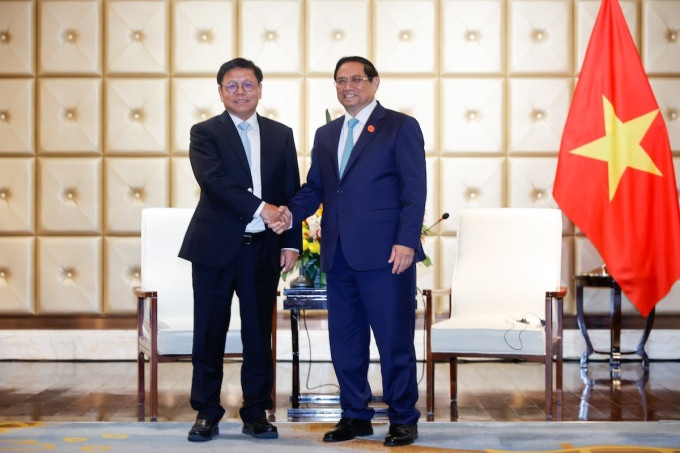The North-South high-speed railway project, over 1,500 km long, is expected to be implemented in 2026-2027, according to Minister of Transport Nguyen Van Thang.
On the afternoon of June 25, Prime Minister Pham Minh Chinh worked with Mr. Lou Qiliang, Chairman of the Board of Directors and General Director of China Railway Signal Corporation (CRSC) in Dalian City (Liaoning Province, China).
CRSC, affiliated to the China State-owned Assets Supervision and Administration Commission (SASAC), the world's largest supplier of railway transport control systems, is China's competent authority for technical standards and product standards of railway transport control systems.
Speaking at the meeting, Minister of Transport Nguyen Van Thang said that according to the plan, Vietnam will develop a North-South high-speed railway system of more than 1,500 km, expected to be deployed before 2030, specifically in the 2026-2027 period. To implement this, he said, Vietnam wants to cooperate with China in the fields of railways, carriages and signals.
"These are three components that play a decisive role in the safety of railway lines, including high-speed and urban railways," said Minister Thang, adding that China has good technology in railway development and reasonable prices, so this is a good opportunity for the two sides to cooperate through support mechanisms such as ODA loans and export credits.
Vietnam aims to have 3,000 km of expressway by 2025 and increase to 5,000 km by 2030. Railway infrastructure, especially the North-South high-speed railway investment project, will be invested in to complete the multimodal transport network and enhance national competitiveness. At the end of November 2023, the Ministry of Transport asked for opinions on three North-South railway scenarios, including two scenarios of 350 km/h trains carrying passengers exclusively and reserve freight.

At the meeting, Prime Minister Pham Minh Chinh assessed that China is a country with strengths in developing high-speed railways and urban railways. He hoped that China would support him in designing, constructing and transferring technology, including developing railway projects from Yunnan through Lao Cai to Hai Phong, the Lang Son route to Hanoi and the Dongxing route to Mong Cai and Hai Phong. These three railway lines are over 700 km long and play an important role in promoting trade between the two countries.
CRSC is currently the largest enterprise in China in the field of railway signaling. In the subway sector alone, the group accounts for a 45% market share. It is also the world's largest supplier of railway transport control systems, building a complete industrial chain from design and R&D to equipment manufacturing and technical services of railway transport control systems.
Mr. Lau Te Luong, Chairman and General Director of CRSC, said that the group wants to have the opportunity to cooperate with Vietnam. Because, this group has strengths from the design to the production of railway control signal systems, including software, digitizing equipment - creating a closed production and supply chain to help with competitive prices, safety and quality.
He also said that human resources play a very important role in developing railway projects. This enterprise can cooperate with Vietnam in the fields of research and development (R&D) and railway signals, because these are important factors in developing the railway system.
Agreeing with this view, Prime Minister Pham Minh Chinh said that training human resources for railway projects in Vietnam is facing difficulties. Therefore, Vietnam wants to cooperate with China in training human resources, command, control, and design in railway projects.
"Human resources must come first, then technology transfer. If product and logistics costs remain high, it will be difficult to compete in the market. Therefore, we hope the group will participate," the Prime Minister said, and at the same time suggested that the group's leaders come to Vietnam to discuss specifically with ministries and sectors to promote the projects.
According to Minister Nguyen Van Thang, the Vietnamese and Chinese governments are directing the implementation of three railway projects connecting the two countries. It is expected that in mid-2025, the two sides will carry out the first project, Lao Cai - Hanoi - Hai Phong.
The Minister of Transport also suggested cooperation in standard gauge railway projects connecting seaports to economic zones, industrial parks, airports and border gates. According to him, these are projects with high economic efficiency, so in addition to projects funded by the State, Vietnam also calls on enterprises such as CRSC to participate in investment through the form of public-private partnership (PPP).
CRSC Group operates in more than 20 countries and regions, including the Jakarta-Bandung HSR project in Indonesia, the Hungary-Serbia Railway and the China-Laos Railway.
VN (synthesis)